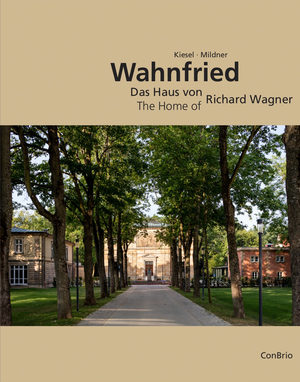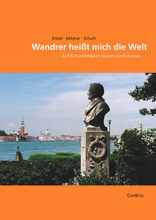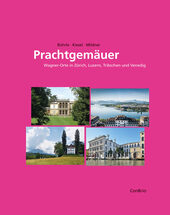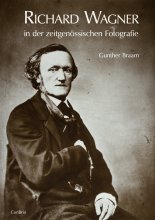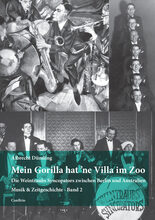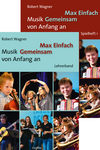Dieses Buch erzählt Geschichte und Geschichten von Wahnfried, dem Haus von Richard Wagner in Bayreuth. Es ist ein zentraler Ort des Lebens und Wirkens eines der bedeutendsten künstlerischen Phänomene des 19. Jahrhunderts und damit einzigartig nicht nur in der Wagner-Topografie Bayreuths, sondern bedeutsam für ganz Deutschland und Europa.
Das Wohnhaus des Dichter-Komponisten ist nicht nur der Ort, an dem wesentliche Spätwerke des Meisters (u.a. Götterdämmerung und Parsifal) erarbeitet wurden, sondern es repräsentiert auch eine ideengeschichtliche Haltung, die im europäischen Geistesleben bis ins 20. Jahrhundert – nicht immer nur positiv – wirkungsmächtig war. Die Konzentrik des „Bayreuther Kreises“ hatte hier seinen Mittelpunkt.
Als Wohnhaus der Familie Wagner bis 1966 stand es zudem im Zentrum des Bayreuther Festspielunternehmens und damit – auch mit seinen zweifelhaften Gästen – im Fokus der Aufmerksamkeit der Weltöffentlichkeit. Die eigentumsrechtlichen und nutzungsspezifischen Veränderungen des Gebäudes im 20. Jahrhundert spiegeln das kulturpolitische Ringen und die Diskussionen um den Fortbestand einer der bedeutendsten Kulturinstitutionen der Welt wider, die bis heute nicht abgeschlossen sind.
Dieses Haus ist ein Erinnerungsort, in dem sich Ideengeschichte, Architekturgeschichte, Musikgeschichte und Kulturgeschichte modellhaft abbilden. Nach einer Grundsanierung und der Errichtung eines Erweiterungsneubaus wurde es als Gedenkstätte und Museum zum Festspielsommer 2015 wiedereröffnet. Zusammen mit dem von Richard Wagner errichteten Festspielhaus Bayreuth und der Grabstätte von Cosima und Richard Wagner bildet Haus Wahnfried ein in der Welt einzigartiges Ensemble.
Der zentrale Text von Verena Naegele wird ergänzt durch Fachbeiträge von Gerte Reichelt, Peter Cachola Schmal, Dietmar Schuth und Volker Staab sowie einem Grußwort von Nike Wagner. Mit historischem und aktuellem Bildmaterial reich illustriert, zeichnet das Buch die faszinierende Geschichte des Hauses von 1872 bis hin zur 2015 fertig gestellten Grundsanierung und Errichtung von Erweiterungsbauten nach.
This book tells the story of Wahnfried – Richard Wagner’s home in Bayreuth. Wahnfried is an integral part of the history and impact of one of the most important artistic phenomena of the 19th century and, as such, is not only uniquely important to the topography of Wagner’s Bayreuth but of major significance in Germany and the wider world.
Wahnfried is not only the place where this poet and composer completed major late works (including Götterdämmerung and Parsifal), it is also associated with certain attitudes in the history of ideas that were to have an influence in Europe – for better and for worse – until well into the 20th century. The waves that rippled outward from the “Bayreuth circle” originated in Wahnfried.
Up until 1966 successive generations of the Wagner family lived at Wahnfried, which thus became the beating heart of Richard Wagner’s Bayreuth Festival. As such – with its houseguests, both famous and infamous – Wahnfried was always in the public eye. Changes in the ownership and use of Wahnfried during the course of the 20th century reflect conflicting cultural and political interests and the ongoing debate surrounding the maintenance of a globally important cultural institution.
This villa is a place of remembrance, which brings together many strands in cultural history – in the history of ideas, architecture, and music. Following its complete refurbishment and renovation, and the construction of a separate extension, Haus Wahnfried was reopened as a memorial and museum during the Bayreuth Festival in the summer of 2015. Together with the Festival Theatre in Bayreuth, constructed to Wagner’s own specifications, and the burial site of Cosima and Richard Wagner, Haus Wahnfried is part of an architectural ensemble that is unmatched anywhere in the world.
A substantial, three-part essay by Verena Naegele is complemented by expert contributions from Gerte Reichelt, Peter Cachola Schmal, Dietmar Schuth, and Volker Staab, and a word of welcome from Nike Wagner. The book is abundantly illustrated with historical as well as contemporary photos. They reveal the fascinating story of the house between 1872 and 2015 when it was thoroughly renovated and the extensions completed.
Inhaltsverzeichnis / Table of contents:
Markus Kiesel, Joachim Mildner: Richard Wagners Haus Wahnfried Richard Wagner’s Haus Wahnfried
Nike Wagner: „O daß wir unsere Ururahnen wären“ “O that we were our own primal ancestors“
Verena Naegele: Künstler in der Bourgeoisie – Ein Heim für Wagner A Bourgeois Family Home for an Artist
1 Wagners Vision einer repräsentativen Familien-Residenz Wagner’s Vision of a Representative Residence
2 Die Neugestaltung Wahnfrieds gerät aus den Fugen Endless Alterations to Wahnfried
3 Von der Wahnfried-Ruine zur Wagner-Gedenkstätte mit Nationalarchiv From the Ruins of Wahnfried to a Wagner Memorial and National Archive
Dietmar Schuth: „Etwas steif symmetrisch, aber schön und sicher“ – Über die äußere Gestalt von Haus Wahnfried “Rather stiffly symmetrical, but beautiful and assured“ – On the Appearance of Haus Wahnfried
Interview mit with Volker Staab: Mehr „Wahn“ als „Fried“ More “Wahn” than “Fried”
Peter Cachola Schmal: Das Richard Wagner-Museum Bayreuth – architektonische Neugestaltung und Erweiterung The Richard Wagner Museum Bayreuth – architectural remodeling and expansion
Gerte Reichelt: Kultureller Ensembleschutz als Element der Erinnerungskultur in Bayreuth – Maßgaben für die Auslegung des Stiftungszwecks Cultural Ensemble protection as element of remembrance culture in Bayreuth – Provisos for the
interpretation of the Foundation's purpose
Biografien
Bildnachweis
